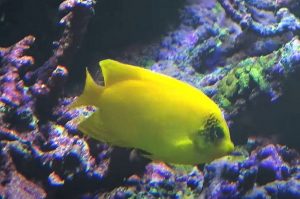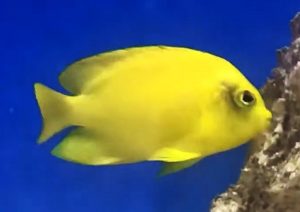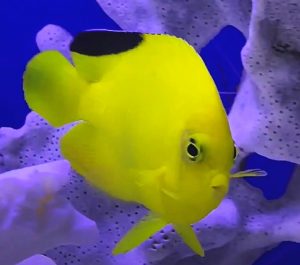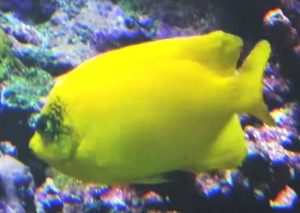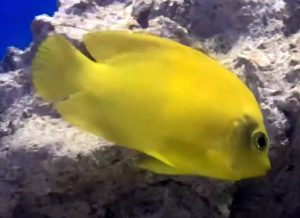Heralds Angelfish (Centropyge Heraldi) known to tropical fish keeping enthusiasts as False Lemonpeel Angelfish, Golden Angelfish, Yellow Pygmy Angelfish or Yellow Angelfish are a common dwarf species that range from Central Pacific to Western Pacific waters. It is found in the Pacific Ocean from Taiwan to the Tuamoto Island, and from Southern Japan to the Great Barrier Reef.
Found throughout the South Pacific, Heralds Angelfish are often misidentified and sold as Lemonpeel Angelfish.
Typical of all dwarf angelfish, Herald’s Angelfish (Centropyge Heraldi) have a small, elongated, oval shaped body and rounded fins. They have a bright yellow body color with a darker colored area just behind the eye.
They lack the blue ring around the eye and dark blue accents around the gills and fins that Lemonpeel Angelfish (Centropyge flavissimus) possess.
Male Herald’s Angelfish have black on the face and in some areas, have darker anal and dorsal fins. Mature males normally have more pointed dorsal and anal fins and often develop a dark area behind the eye that may contain yellow spots.
A unique variant of Heralds Angelfish from the Coral Sea area of the Great Barrier Reef called the Yellow and Black Heralds Angelfish or Woodhead’s Angelfish is occasionally available to tropical fish keeping enthusiasts.
In the Coral Sea area of the Great Barrier Reef, the Solomon Islands, Fiji, Tonga, and the Philippines, this species is colored bright yellow with a jet black horizontal band or stripe edged in blue on the top rear half of the dorsal fin. Some specimens also have a black saddle on the back and others posses both attributes.
Originally believed to be a different species described as Centropyge woodheadi and named Woodhead’s Angelfish; it is now considered to be a color variant.
Herald’s Angelfish are active, interesting swimmers and can make a colorful addition to an established marine aquarium. Like all dwarf angelfish, they are peaceful with all other marine fish except other dwarf angels. It does well in a community aquarium with peaceful or semi aggressive fish provided it is added to the tank close to last.
Herald’s Angelfish can be highly territorial and become extremely aggressive when housed with other dwarf angels and towards fish with similar coloration or shape, especially the Lemonpeel Angelfish.
If you must try to breed them or keep a pair or a trio, a very large aquarium of at least 150 gallon capacity with a huge amount of live rock is necessary to provide enough grazing territory for each fish.
A single Juvenile Herald’s Angelfish can be housed in an aged aquarium as small as 30 gallons, provided a sufficient amount of live rock is present for them graze on micro algae and hide among when threatened.
Although Centropyge Heraldi can be kept in a 30 gallon tank; as they grow, they do better when kept in an aged aquarium of at least 55 gallon capacity or larger. An “aged aquarium” should be at least 6 months old to provide all the necessary algae required to feed your angelfish.
Heralds Angelfish are easier to keep than Lemonpeel Angelfish and do best in reef settings with substantial amounts of live rock arranged into shelters and hiding places. Large amounts of live rock are needed to provide enough grazing area for microalgae growth that is necessary to maintain the health of the fish.
Like Lemon Peel Angelfish; Heralds Angelfish will nip away at some of the reef structure, especially large polyped stony corals and clam mantles, but in general they are not too destructive, especially with noxious corals.
The neat thing about this angelfish is their desire to eat detritus and micro algae, both of which are unwanted in a reef tank. They will completely ignore non-sessile invertebrates such as shrimp and crabs and will also help control several types of algae and diatoms in the tank.
Water quality is essential to all marine residents, so a good filtration system and regulator water changes are mandatory. In an aquarium of 55 to 65 gallon capacity, a 10% to 15% bi weekly water change is recommended. In an aquarium over 100 gallons, a 20% monthly water change would be considered normal maintenance. Because Heralds Angelfish are constant grazers, water changes should NOT include scrubbing algae off of the interior of the aquarium.
As of this date, Centropyge Heraldi have not been bred in an aquarium environment.
In their natural environment, Herald’s Angelfish are egg scatterers, and like all Centropyge angelfish have similar spawning rituals. The male will normally court several females. A pair will circle each other and when ready to spawn will swim upwards in the water column to fertilize the eggs. After the eggs are fertilized by belly to belly contact, they free float until they are mature enough to settle into the substrate and hatch into larvae. The larvae are given no parental supervision or protection.
After spawning, the pair will rush back to the bottom where the male will chase the female for a short time and then move on to the next receptive female.
Herald’s Angelfish are algae grazers that feed mainly on algae, small crustaceans, and worms that may be hiding in the algae. In an aquarium environment, to supplement the natural algae growth on your live rock in the tank, they should be offered a diet of Spirulina, marine algae, Mysis
, brine, or frozen shrimp, high quality angelfish preparations, and other meaty items. Feed them what they will consume within a few minutes 2 to 3 times a day. Without herbivore foods in their diet, angelfish can develop blindness in just a few months
This dwarf angelfish is often sold as part of a “cleaning crew” to control the green algae Crunchy Hair Grass of the Boodlea genera, several Green Hair Algae Derbesia species including Derbesia marina, Diatoms, Green String Lettuce, some other hair like algae, and the Sea Lettuces Ulva ridida and Ulva lactuca. It is also known to eat red slime algae including two species of the Oscillatora genera.
Herald’s Angelfish (Centropyge Heraldi) are sometimes available to tropical fish keeping enthusiasts in pet shops and on line from importers, online auction sites, and a variety of online retail sources at reasonable prices.
Minimum Tank Size: 30 gallons
Aquarium Type: Reef Compatible With Caution
Care Level: Intermediate
Temperament: Semi-aggressive
Aquarium Hardiness: Moderately Hardy
Water Conditions: 72-82°F, 8 to 12 dGH , pH 8.1 – 8.4, sg 1.023-1.025
Max. Size: 4″
Color Form: Yellow, Black
Diet: Omnivore
Compatibility: Single species
Origin: Western Pacific, Central Pacific
Family: Pomacanthidae
Lifespan: 10 years
Aquarist Experience Level: Intermediate


